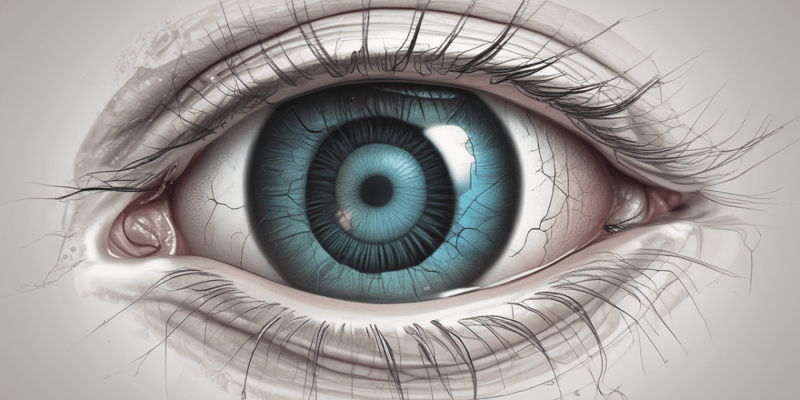Podcast
Questions and Answers
Bilateral lesions in the visual cortex will produce complete blindness
Bilateral lesions in the visual cortex will produce complete blindness
True
Lesions before the optic chiasm affect the same regions of the fields of both eyes
Lesions before the optic chiasm affect the same regions of the fields of both eyes
False
A homonymous visual field defect is caused by a lesion in one eye
A homonymous visual field defect is caused by a lesion in one eye
False
The optic radiations are involved in retrochiasmatic lesions
The optic radiations are involved in retrochiasmatic lesions
Signup and view all the answers
A lesion in the medial optic radiation/Cuneus results in contralateral homonymous hemianopsia
A lesion in the medial optic radiation/Cuneus results in contralateral homonymous hemianopsia
Signup and view all the answers
Bilateral occipital lobe lesions can result in complete blindness
Bilateral occipital lobe lesions can result in complete blindness
Signup and view all the answers
All recti muscles are abductors.
All recti muscles are abductors.
Signup and view all the answers
The superior oblique muscle is an elevator.
The superior oblique muscle is an elevator.
Signup and view all the answers
The trochlear nerve (CN IV) innervates the lateral rectus muscle.
The trochlear nerve (CN IV) innervates the lateral rectus muscle.
Signup and view all the answers
The action of EOMs is limited to one axis of movement.
The action of EOMs is limited to one axis of movement.
Signup and view all the answers
The superior rectus muscle is a depressor.
The superior rectus muscle is a depressor.
Signup and view all the answers
All inferior muscles are intorters.
All inferior muscles are intorters.
Signup and view all the answers
The oculomotor nerve (CN III) innervates the lateral rectus muscle.
The oculomotor nerve (CN III) innervates the lateral rectus muscle.
Signup and view all the answers
The oculomotor nerve nucleus is located at the level of the inferior colliculus of the midbrain.
The oculomotor nerve nucleus is located at the level of the inferior colliculus of the midbrain.
Signup and view all the answers
The trochlear nerve supplies the superior oblique muscle.
The trochlear nerve supplies the superior oblique muscle.
Signup and view all the answers
The lateral nucleus of the oculomotor complex supplies the superior, medial, and inferior recti, and inferior oblique muscles.
The lateral nucleus of the oculomotor complex supplies the superior, medial, and inferior recti, and inferior oblique muscles.
Signup and view all the answers
The nucleus of Perlia is responsible for supplying the levator palpebrae superioris.
The nucleus of Perlia is responsible for supplying the levator palpebrae superioris.
Signup and view all the answers
The Edinger-Westphal nuclei are responsible for vertical eye movement.
The Edinger-Westphal nuclei are responsible for vertical eye movement.
Signup and view all the answers
The trochlear nerve is responsible for supplying the inferior oblique muscle.
The trochlear nerve is responsible for supplying the inferior oblique muscle.
Signup and view all the answers
The association nuclei are responsible for convergence.
The association nuclei are responsible for convergence.
Signup and view all the answers
When the head turns to the left, the eye turns to the left
When the head turns to the left, the eye turns to the left
Signup and view all the answers
The frontal eye field is involved in the control of vertical saccades
The frontal eye field is involved in the control of vertical saccades
Signup and view all the answers
The pathway for smooth pursuit eye movements involves BA 8
The pathway for smooth pursuit eye movements involves BA 8
Signup and view all the answers
The vergence pathway utilizes the saccadic pathway
The vergence pathway utilizes the saccadic pathway
Signup and view all the answers
The optic radiations are involved in the saccadic pathway
The optic radiations are involved in the saccadic pathway
Signup and view all the answers
The trochlear nucleus supplies the superior rectus muscle
The trochlear nucleus supplies the superior rectus muscle
Signup and view all the answers
The posterior commissures are involved in the decussation of some fibers in the saccadic pathway
The posterior commissures are involved in the decussation of some fibers in the saccadic pathway
Signup and view all the answers
The RiMLF is involved in the control of vertical gaze
The RiMLF is involved in the control of vertical gaze
Signup and view all the answers
The CN III nuclei supply the lateral rectus muscle
The CN III nuclei supply the lateral rectus muscle
Signup and view all the answers
Study Notes
EOMs General Actions
- All recti muscles are adductors, except lateral rectus which is an abductor
- All oblique muscles are abductors
- Superior muscles are intorters (medial rotators)
- Inferior muscles are extorters (lateral rotators)
- Superior oblique and inferior rectus are depressors
- Inferior oblique and superior rectus are elevators
- Action of muscles is not limited to one axis
Innervation of EOMs
- Oculomotor Nerve (CN III) innervates:
- Superior, medial, and inferior recti
- Inferior oblique
- Levator palpebrae superioris
- Trochlear nerve (CN IV) innervates:
- Superior oblique
- Abducens Nerve (CN VI) innervates:
- Lateral rectus
Optic and Extraocular Motor Pathways
- Bilateral occipital lobe lesions can result in complete blindness
- Lesions after the optic chiasm affect:
- Optic tracts
- LGB
- Optic radiations
- Visual Cortex
- Such lesions generally cause a homonymous visual field defect
Reflexes
- VOR (Vestibulo-Ocular Reflex) pathway:
- Inputs are contralateral
- Frontal eye field → Corona radiata and anterior limb of the internal capsule → Pretectal region of RiMLF → CN III and IV nuclei
- Saccadic system:
- Horizontal gaze: Inputs are contralateral
- Vertical saccade: Impulses from BA 8 (frontal eye field) → Corona radiata and anterior limb of the internal capsule → Pretectal region of RiMLF → CN III and IV nuclei
- Smooth pursuit system:
- Same pathway as saccade, but visual impulses come from BA 18, 19 and are ipsilateral
- Vergence pathway:
- Utilizes the accommodation reflex pathway
- Visual impulses come from BA 18, 19 → Superior colliculi → Optic radiation → CN III nuclei
Anatomy of Optic and Extraocular Motor Pathways
- Outline of the visual reflex pathway
- Pupillary light reflex: A and B layers of the neural retina
- Important cells: Rods and cones
- Accommodation/Convergence reflex: Ciliary muscles and sphincter pupillae
- Visual field: Optic radiations and visual cortex
Studying That Suits You
Use AI to generate personalized quizzes and flashcards to suit your learning preferences.
Description
This quiz covers the anatomy of the optic and extraocular motor pathways, including the neural retina, pupillary light reflex, accommodation, convergence, and visual field. It also reviews the neuroanatomical basis of extraocular movement and clinical correlations. Test your knowledge of the eye's anatomy and functions!





